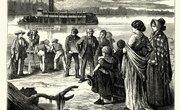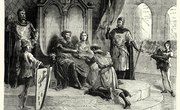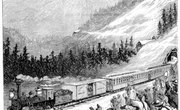German immigrants were an important subset of American culture from before the Revolution, but they made their greatest impact beginning in the 1840s and 1850s, when over a million migrated to the U.S., primarily to escape political upheaval. Once here, these immigrants made important contributions to American society.
Farmers and Laborers
The majority of German immigrants settled in the rural Midwest, but they also established the town of New Braunfels, Texas, and its surrounding areas in 1845. They also built ethnic enclaves in the Midwest metropolises of Milwaukee and Chicago. Many Germans were farmers, bringing with them their Old World practices. Others were craftsmen such as furniture-makers, brewers, metalworkers and engineers. Many of these craftsmen joined the growing urban factories, to which they introduced their craft guild tradition. This tradition soon evolved into trade unions, and from there the labor union movement emerged, reaching its peak in the late 19th and early 20th century.
Politics
Many Germans who immigrated in the 1850s did so as a result of the failed democratic revolutions of 1830 and 1848 in Vienna, Berlin and much of southwest Germany. They carried their political aspirations to America, where they formed a significant voting bloc, and introduced political ideologies such as anarchism and socialism to their new communities. Many of these political ideals would be influential to labor unions in the coming decades. German immigrants also went on to serve in politics. After Carl Schurz participated in the failed 1848 political uprisings, he moved to Wisconsin and became a popular political speaker known for his anti-slavery views. Schurz helped rally the German vote for President Abraham Lincoln in 1860, and later served as a Union general, Spanish ambassador, U.S. Senator and Secretary of the Interior.
Education
Many Germans who emigrated in the 1840s and 1850s were well-educated, particularly in comparison to the average American. German immigrants placed great emphasis on early public education, which they enjoyed in their homeland. In 1857, Margaretha Meyer Schurz, Carl Schurz's wife, established the first American kindergarten in Wisconsin. The schools spread rapidly. Germans also established their own newspapers; educational, musical, and philosophical clubs; and various organizations in their new hometowns.
Cultural Contributions and Inventions
German immigrants settled primarily in ethnic enclaves and all-German towns, but their cultural traditions and foods soon spread to the American masses. Beginning in the 1850s, German Christmas traditions, particularly the Christmas tree, became popular in the United States as part of an effort to "revive Christmas" in response to economic and political upheaval. Perhaps the most long-lasting and popular German contribution is beer. The Anheuser-Busch Brewing Association, maker of Budweiser, was established by a German immigrant in 1857.
Related Articles
References
Writer Bio
Based in Dallas, Exa von Alt has been working in education and the social sciences for nearly 10 years. Her lesson plans are published on the University of Oklahoma's K20ALT website and she has written several entries in "American Centuries: The Ideas, Issues, and Trends that Made U.S. History"(MTM Publishing). Exa von Alt holds a Master of Arts in history from the University of Illinois at Chicago.











